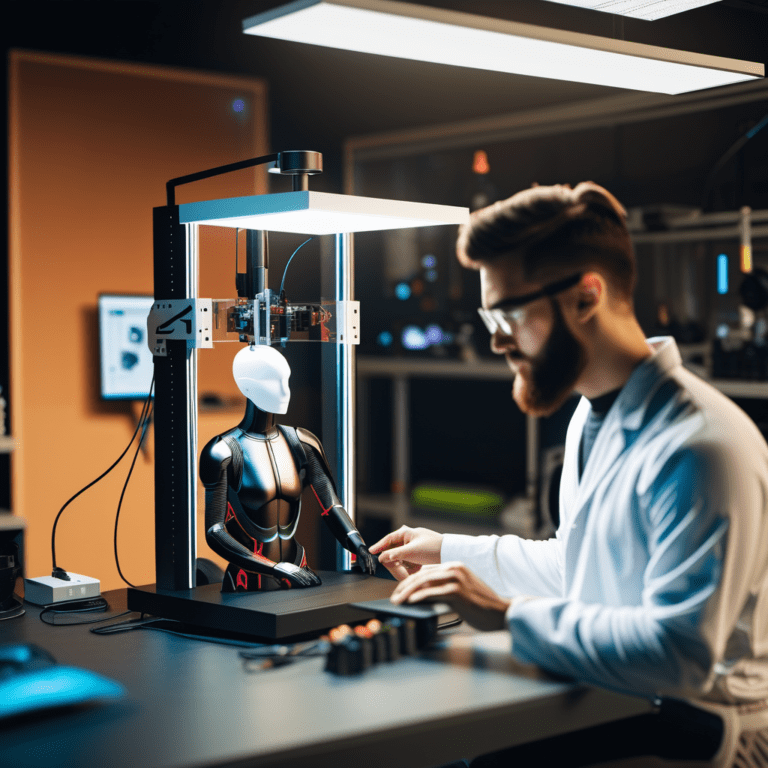Sci-Fi to Reality: The Remarkable Stories of Human Augmentation Experiments
- Introduction to human augmentation experiments
- History of human augmentation
- Types of human augmentation experiments
- Benefits and potential risks of human augmentation
- Ethical considerations in human augmentation experiments
- Current advancements in human augmentation technology
- Examples of successful human augmentation experiments
- Challenges and limitations in human augmentation
- Conclusion: Implications and considerations for the future of enhanced abilities
Introduction to human augmentation experiments
Human augmentation experiments have long fascinated scientists, philosophers, and the general public. The idea of enhancing human abilities beyond their natural limits has been a topic of discussion for centuries. In recent years, advancements in technology have brought us closer to turning these experiments into reality.
The goal of human augmentation experiments is to improve human performance, health, and quality of life. For example, prosthetics can help people with disabilities regain mobility, while exoskeletons can give people superhuman strength and endurance. Brain-computer interfaces could allow people to control machines with their minds, and genetic engineering could be used to cure diseases and improve human intelligence.
History of human augmentation
The concept of human augmentation can be traced back to ancient civilizations, where individuals sought to enhance their physical abilities through various means. From the use of prosthetic limbs in ancient Egypt to the development of eyeglasses in the Middle Ages, humans have always sought ways to improve their capabilities.
In ancient mythology, gods and goddesses were often depicted with superhuman abilities. In modern science fiction, human augmentation is a common theme.
The first human augmentation experiments were conducted in the early 20th century. In the 1950s, the US military began developing prosthetics and exoskeletons for soldiers. In the 1960s, the first cochlear implants were developed to help people with hearing loss.
In recent years, there has been a surge of interest in human augmentation. This is due in part to advances in technology, such as artificial intelligence, nanotechnology, and 3D printing.

Types of human augmentation experiments
Human augmentation experiments can be divided into two main categories:
- Restorative augmentation: This type of augmentation is used to restore lost or damaged functions. For example, prosthetics can be used to replace lost limbs, and cochlear implants can be used to restore hearing.
- Enhancement augmentation: This type of augmentation is used to improve human abilities beyond their natural limits. For example, exoskeletons can be used to increase strength and endurance, and brain-computer interfaces could be used to improve cognitive function.
Benefits and potential risks of human augmentation
The potential benefits of human augmentation are vast. Physical augmentation can help individuals with disabilities regain their mobility and independence. Cognitive augmentation can enhance learning capabilities and improve decision-making processes. However, along with these benefits come potential risks. The misuse of human augmentation technology could lead to inequality, discrimination, and the erosion of human dignity.
Human augmentation has the potential to offer a number of benefits, including:
- Improved quality of life
- Increased productivity
- Enhanced cognitive abilities
- Improved health
- New opportunities for exploration and discovery
However, there are also potential risks associated with human augmentation, such as:
- Unintended consequences
- Ethical concerns
- Safety risks
- Security risks
- Inequality
Ethical considerations in human augmentation experiments
As with any emerging technology, human augmentation experiments raise ethical concerns. Questions regarding consent, privacy, and the equitable distribution of resources need to be addressed. It is crucial to ensure that human augmentation is used for the betterment of society as a whole, rather than for the benefit of a select few.
Human augmentation experiments raise a number of ethical concerns, such as:
- Consent: Is it possible to obtain meaningful consent from participants in human augmentation experiments?
- Justice: Who should have access to human augmentation technologies?
- Safety: How can we ensure the safety of human augmentation technologies?
- Identity: How will human augmentation technologies impact our sense of self?
- Meaning: What does it mean to be human in an age of human augmentation?
Current advancements in human augmentation technology
Recent advancements in technology have paved the way for groundbreaking human augmentation experiments. The development of exoskeletons has allowed individuals with spinal cord injuries to walk again. Brain-computer interfaces have enabled paralyzed patients to control robotic limbs using their thoughts. These advancements have the potential to revolutionize the field of medicine and improve the quality of life for millions of people.
Examples of successful human augmentation experiments
One notable example of a successful human augmentation experiment is the case of Oscar Pistorius, a South African sprinter with bilateral leg amputations. Pistorius used carbon-fiber prosthetic blades, known as “Cheetahs,” to compete in the Olympic Games alongside able-bodied athletes. His achievements sparked a global conversation about the boundaries of human potential.
There are a number of exciting advancements in human augmentation technology happening right now. For example:
- Prosthetics: Prosthetic limbs are becoming increasingly sophisticated and realistic. Some prosthetic limbs are now controlled by myoelectric signals from the user’s muscles.
- Exoskeletons: Exoskeletons are becoming more affordable and accessible. Some exoskeletons are now being used by workers in industrial settings to help them lift heavy objects and reduce fatigue.
- Brain-computer interfaces: Brain-computer interfaces are becoming increasingly sophisticated and reliable. Some brain-computer interfaces are now being used to help people with disabilities control devices such as wheelchairs and prosthetic limbs.
- Genetic engineering: Genetic engineering is still in its early stages of development, but it has the potential to be used to cure diseases and enhance human abilities.
There have been a number of successful human augmentation experiments conducted in recent years.
- In 2012, a man named Dennis Aabo became the first person to receive a bionic arm that is controlled by his mind.
- In 2014, a woman named Jan Scheuermann became the first person to receive a brain implant that allows her to control her prosthetic hand with her mind.
- In 2017, a man named Nick Newell became the first professional fighter with a prosthetic limb to compete in a sanctioned mixed martial arts match.
- In 2018, a man named Alex Honnold became the first person to free solo climb El Capitan in Yosemite National Park. He used a new type of climbing shoe that gave him more grip and control.
- In 2019, a woman named Jessica Cox became the first person with no arms to earn a pilot’s license. She uses her feet to control the plane.
- In 2020, a man named Neil Harbisson became the first person to have a cybernetic antenna implanted in his skull. The antenna allows him to perceive colors outside of the visible spectrum.
- In 2021, a woman named Lizzie Velásquez became the first person to receive a retinal implant that partially restored her sight. She was born with a rare condition that caused her to be blind.
- In 2022, a man named Niels Vellinga became the first person to have a brain implant that allowed him to communicate with a computer using his thoughts. He is paralyzed from the neck down.

Challenges and limitations in human augmentation
Despite the progress made in human augmentation experiments, there are still significant challenges and limitations to overcome. The development of safe and reliable augmentation technologies is a complex task that requires extensive research and testing. Additionally, the high cost of these technologies limits their accessibility to a select few.
There are still a number of challenges and limitations that need to be addressed before human augmentation technologies can be widely adopted. These challenges include:
- Cost: Many human augmentation technologies are still very expensive.
- Safety: It is important to ensure the safety of human augmentation technologies before they are widely used.
- Ethics: The ethical concerns surrounding human augmentation need to be carefully considered.
Conclusion: Implications and considerations for the future of enhanced abilities
As we venture further into the realm of human augmentation experiments, it is crucial to approach this field with caution and responsibility. While the potential benefits are undeniable, we must also consider the ethical implications and ensure that these advancements are used for the greater good. The future of enhanced abilities lies in our hands, and it is up to us to shape it in a way that benefits all of humanity.
Information is gathered with a help of Bard
Ready to embark on a journey into the future of human potential? Click InnoVirtuoso – Brain Computer Interface Topics now to start exploring! Don’t miss out on the chance to expand your horizons, challenge your perspectives, and stay informed about the incredible world of Brain-Computer Interfaces.






